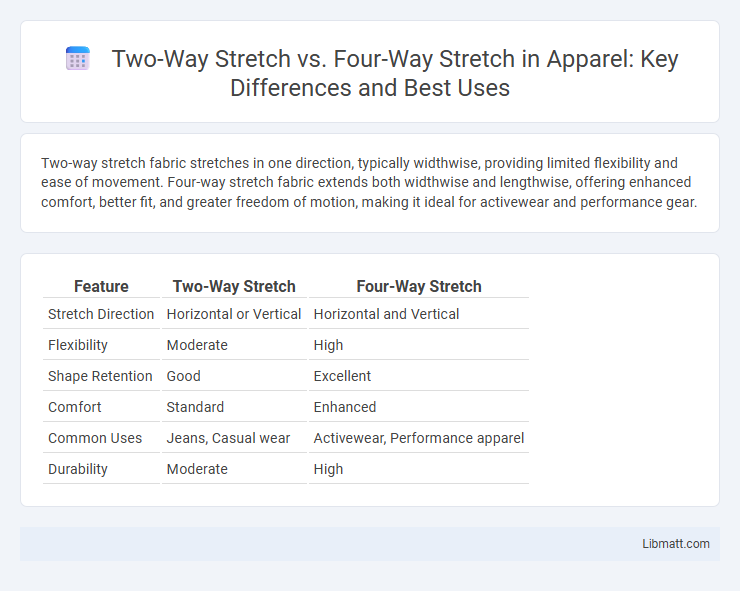Two-way stretch fabric stretches in one direction, typically widthwise, providing limited flexibility and ease of movement. Four-way stretch fabric extends both widthwise and lengthwise, offering enhanced comfort, better fit, and greater freedom of motion, making it ideal for activewear and performance gear.
Table of Comparison
| Feature | Two-Way Stretch | Four-Way Stretch |
|---|---|---|
| Stretch Direction | Horizontal or Vertical | Horizontal and Vertical |
| Flexibility | Moderate | High |
| Shape Retention | Good | Excellent |
| Comfort | Standard | Enhanced |
| Common Uses | Jeans, Casual wear | Activewear, Performance apparel |
| Durability | Moderate | High |
Understanding Fabric Stretch: Two-Way vs. Four-Way
Two-way stretch fabric stretches primarily in one direction, either horizontally or vertically, providing moderate flexibility ideal for casual wear or light activities. Four-way stretch fabric extends both horizontally and vertically, delivering superior mobility and comfort crucial for performance wear, activewear, and garments requiring enhanced shape retention. Your choice between these fabrics affects durability, fit, and freedom of movement depending on the intended use.
What is Two-Way Stretch Fabric?
Two-way stretch fabric stretches primarily in one direction, either horizontally or vertically, enhancing comfort and fit in garments like t-shirts and casual wear. This fabric typically combines spandex with woven or knit materials to allow limited elasticity, improving mobility without excessive distortion. Its elasticity improves flexibility while maintaining structural stability, making it ideal for everyday apparel that requires moderate stretch.
What Defines Four-Way Stretch Fabric?
Four-way stretch fabric is defined by its ability to stretch both horizontally and vertically, offering greater flexibility and range of motion compared to two-way stretch fabric, which only stretches in one direction. This multidirectional elasticity enhances comfort and fit, making four-way stretch materials ideal for activewear, performance gear, and ergonomic apparel. The fabric typically incorporates spandex or elastane fibers woven into the textile to achieve this superior stretch and recovery.
Key Differences Between Two-Way and Four-Way Stretch
Two-way stretch fabric stretches primarily in one direction, either horizontally or vertically, offering basic flexibility ideal for casual wear or light activities. Four-way stretch fabric extends both horizontally and vertically, providing enhanced flexibility and freedom of movement, making it perfect for activewear and performance gear. Understanding these key differences helps you select the most suitable fabric for comfort and functionality in your clothing.
Advantages of Two-Way Stretch Materials
Two-way stretch materials offer enhanced comfort and flexibility by allowing fabric to extend primarily in one direction, making them ideal for activities requiring controlled movement. These materials provide better shape retention and durability compared to four-way stretch, reducing wear and tear over time. Your garments made with two-way stretch fabric often deliver a snug fit that supports movement without excess looseness.
Benefits of Four-Way Stretch Textiles
Four-way stretch textiles offer superior flexibility by stretching both crosswise and lengthwise, providing greater freedom of movement compared to two-way stretch fabrics, which stretch only in one direction. This multidirectional elasticity enhances comfort and fit, making them ideal for activewear, sportswear, and performance apparel. Improved durability and shape retention are additional benefits, ensuring garments made from four-way stretch materials maintain their form and support during intense physical activities.
Best Applications for Two-Way Stretch Fabrics
Two-way stretch fabrics stretch in one direction, making them ideal for applications like upholstery, curtains, and casual wear where flexibility along a single axis is sufficient. Sportswear, leggings, and fitted garments benefit from this controlled stretch, providing comfort and shape retention without excessive give. When choosing fabrics for your project, consider two-way stretch for designs requiring moderate elasticity and structural support.
Ideal Uses for Four-Way Stretch Materials
Four-way stretch materials offer exceptional flexibility, allowing fabric to stretch both crosswise and lengthwise, which makes them ideal for activewear, athletic apparel, and performance gear requiring maximum mobility. Your movements remain unrestricted in activities such as yoga, running, or dance, where dynamic stretching and recovery of the fabric are essential. This versatility enhances comfort, durability, and fit, making four-way stretch fabrics a preferred choice for high-intensity sports and fitness apparel.
How to Choose the Right Stretch Fabric for Your Project
Two-way stretch fabric stretches primarily in one direction, making it ideal for projects requiring moderate flexibility, such as simple dresses or fitted tops. Four-way stretch fabric stretches both horizontally and vertically, providing maximum comfort and mobility, perfect for activewear or garments needing enhanced durability and shape retention. Consider the movement and fit needed for your project, and choose four-way stretch for versatile, form-fitting designs or two-way stretch for less active applications to ensure your garment performs well.
Final Thoughts: Two-Way Stretch vs. Four-Way Stretch
Two-way stretch fabrics extend primarily in one direction, offering flexibility suitable for casual wear and light activities, while four-way stretch materials expand both vertically and horizontally, providing enhanced mobility and durability ideal for activewear and performance gear. Choosing between two-way and four-way stretch depends on the level of comfort, range of motion, and specific use-case, with four-way stretch generally preferred for intensive physical activities due to its superior elasticity. Understanding these differences ensures optimal fabric selection tailored to the demands of the intended application.
two-way stretch vs four-way stretch Infographic

 libmatt.com
libmatt.com